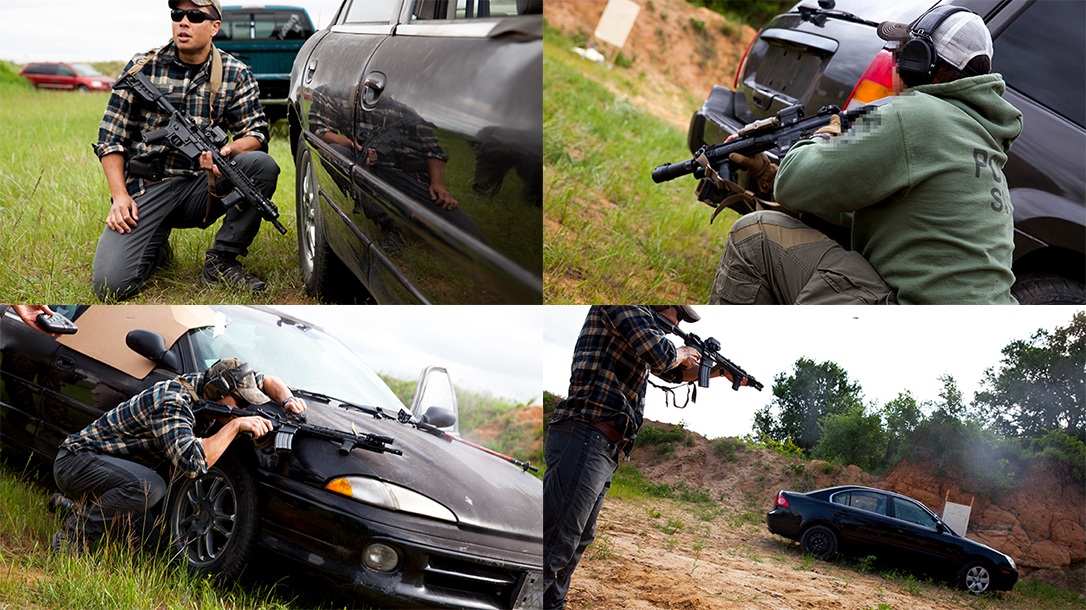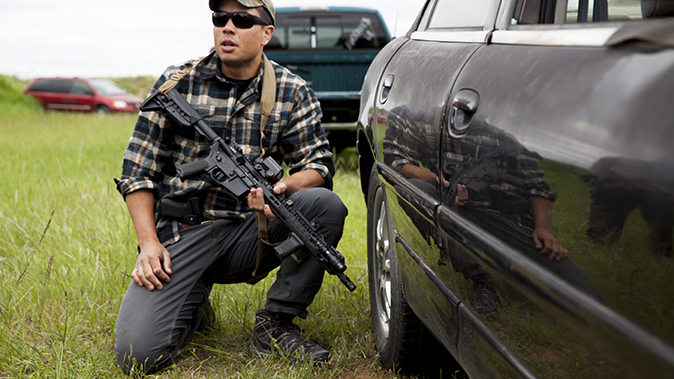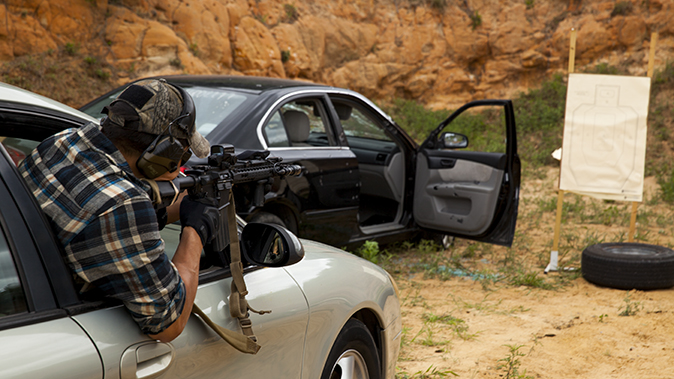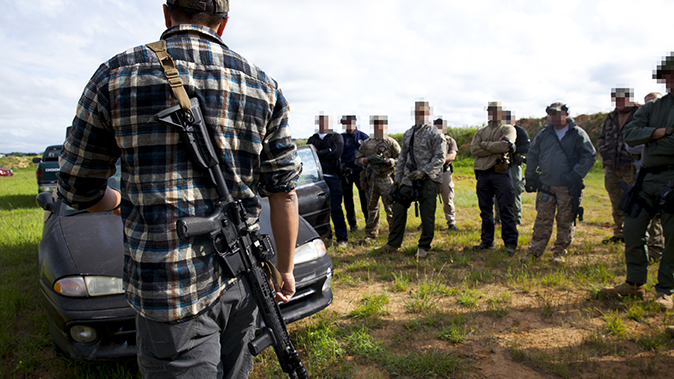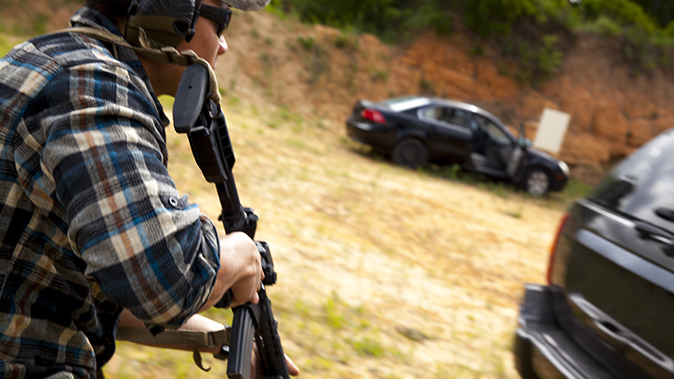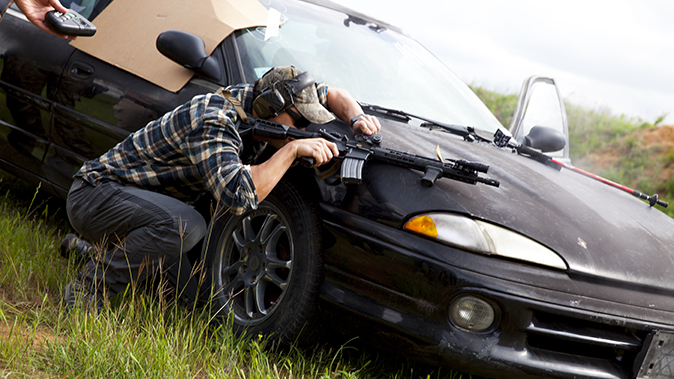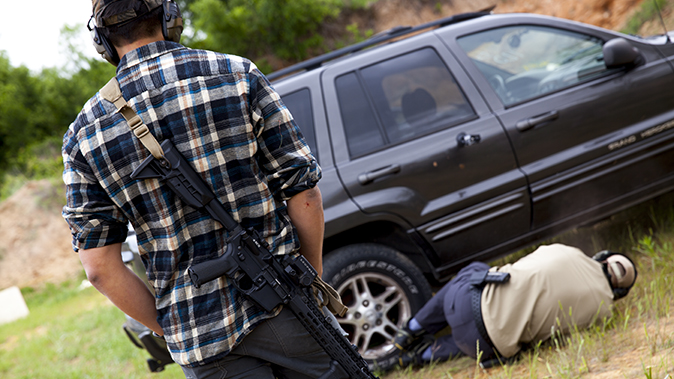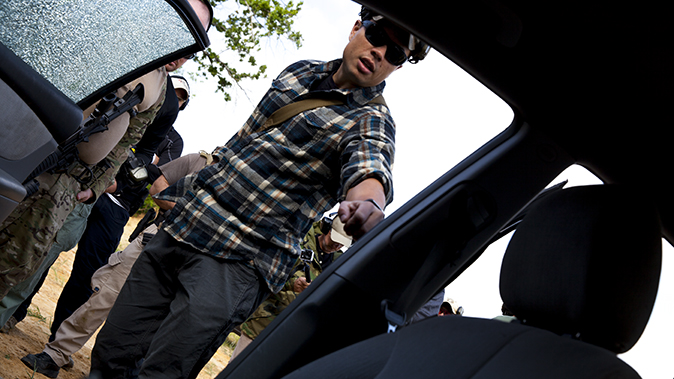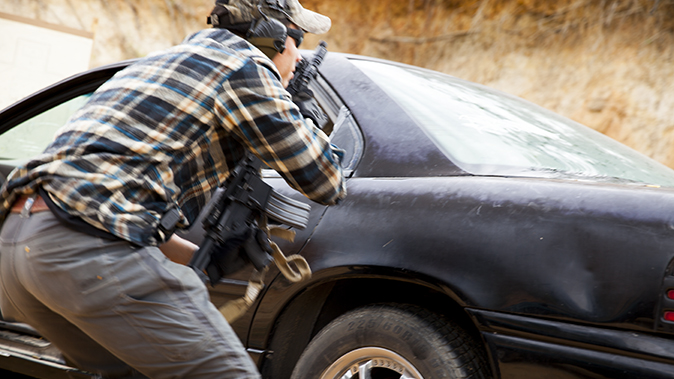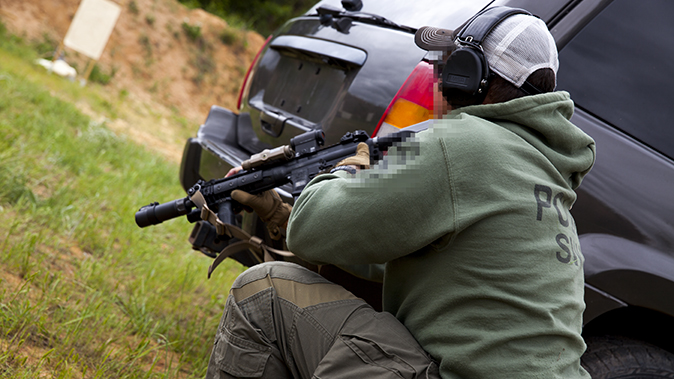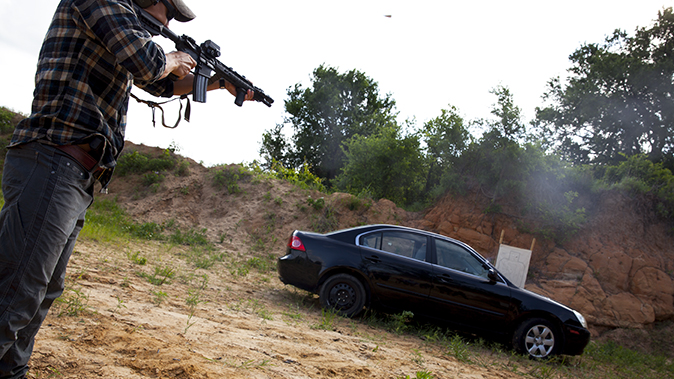A shooting is different than a shootout. A shooting is an exchange of bullets between two individuals. Whether in extreme close quarters or at distance, this event ends after one party has been eliminated or fled the scene. Although still extremely dangerous, this is different than a shootout. A shootout relates to complex attacks such as ambushes in which there are multiple attackers shooting from multiple positions. These types of events are less spur of the moment and can be the result of weeks of prior coordination.
Traditional law enforcement training structured around lethal encounters prepares officers for shootings, not shootouts. Although there are specialized units designed for combatting complex attacks, the scope and nature of day-to-day policing does not immediately demand uniformed police officers be prepared to respond to these crises. Regardless, this does not mean that a patrol officer is excused from being the first responder to a complex attack.
Advertisement — Continue Reading Below
Lone-wolf terrorists, ISIS sympathizers and coordinated gang members have demonstrated the need for all law enforcement officers to be prepared to respond to shootouts. However, the tactics used during these altercations can be different in nature than the methods used for a short-duration shooting. Forward-thinking police officers are recognizing these differences and are challenging traditional training methods. Central to much of their debates are vehicles, because vehicles are central to all policing activities.
Car Shooting Stats
“We tend to base a lot of our tactics around statistics. This isn’t necessarily bad, but sometimes we focus on the wrong aspects of data. The standard OIS [officer-involved shooting] occurs within 7 yards and is over in five seconds. That is good data to know, but it sometimes becomes the extent of our tactical training. We learn techniques suitable for those five seconds, but the moment the fight hits six seconds, or if there’s another shooter involved, a lot of our techniques go right out the window.”
The quoted officer refers to the incompatibility of techniques designed for OISs that occur at traffic stops, versus firefights that occur under any other criteria. His comment also highlights the issue with setting the highest level of training at the median threat, as opposed to scaling back from the most dangerous, yet still likely, encounters.
Advertisement — Continue Reading Below
During a traffic stop, an officer can anchor the suspect’s location to a vehicle. Although he might not know the suspect’s intent, this still removes the incredible burden of identifying the opposition’s location during a gunfight. Unlike a traffic stop, shootouts and ambushes do not afford officers the opportunity to narrow down where the opposition is located before the gunfire starts. In fact, unless you are already aligned with a threat, it is really hard to tell where incoming fire is originating from.
Cover Matters
In a one-on-one shooting, an officer can maneuver at offset distances of up to 10 or 15 yards behind a vehicle. The reasoning behind this states that because the officer is at distance, he decreases the chance of excessive movement that might overexpose his silhouette. In addition, it is argued that because bullets can deflect off of vehicles, officers stand less of a chance of being struck by errant bullets if they remain farther back and under the angle of bullet deflection.
In a fight against multiple gunmen (or even a single gunman that continuously moves), however, offsetting cover by 10 to 15 yards dangerously overexposes an officer on his flanks. Distancing himself from terrain also causes him to expose more of his silhouette than if he were up close. Even if he crouches to compensate, because he is at distance, his sense of spatial awareness is still distorted. Under these circumstances, he need not worry about bullet deflection because he’s actually presented himself as a larger target. This highlights another problem with the argument regarding bullet deflection because it relies on the enemy being a bad marksman, thus reinforcing the earlier quote about focusing on the wrong aspects of data.
Advertisement — Continue Reading Below
Another oft-ignored variable regarding offsetting or moving close to vehicular cover is violence of action, or lethal decisiveness. Violence of action—the unrestricted use of surprise, speed, strength and aggression—is often left out as a determining variable because of an individual’s lack of familiarity with classic tactical theory. Unaware of this variable, an individual is more likely to mislabel significance when dissecting a shooting. For example, dashboard and security camera footage will be misused in arguing for or against offsetting cover, when in fact violence of action was the determining factor.
Get Off The “X”
If you’re ambushed, mobility becomes paramount. If an officer can continue to drive his vehicle, he should continue to do so. In the event an officer is dismounted or if the vehicle becomes immobilized, it’s time to ditch it. Vehicle bailouts and “getting off the ‘X’” are also misunderstood concepts that originate from mixing traffic stop techniques with shootout tactics. Vehicles offer unpredictable amounts of ballistic protection but have traditionally been codified as poor cover.
However, because OISs that originate from traffic stops can result in the minimal exchange of gunfire (because either the suspect or the officer is dead), it creates a false sense of security and the incorrect assumption that vehicles afford more protection than they actually do. Even if a vehicle could stop an infinite number of rounds, it doesn’t matter during an ambush or shootout because the opposition is capable of maneuvering. Ambush sites are selected based on the characteristics of terrain. Whether hasty or preplanned, an ambusher selects a kill zone based on his perceived ability to inflict the maximum amount of damage when a victim is within that area.
Advertisement — Continue Reading Below
If a victim attempts to fight strictly from a kill zone, he will be fighting from a disadvantaged position the entire time until he is likely killed. However, even the best selected ambush site is exploitable by movement. Regardless of location, every kill zone has left, right, front and rear limits in which the terrain no longer affords the attacker an advantage. This is why movement is stressed and officers are not encouraged to attempt to fight from their vehicles when ambushed.
After Moving
Maintaining situational awareness during a complex attack is critical. An officer should never position himself to shoot underneath a vehicle unless it is out of absolute desperation, or because there is a tactical advantage to immediately exploit. Unnecessarily getting into a prone position underneath a vehicle drastically limits an officer’s situational awareness, limits his angles of fire and increases the lethality of rounds that are ricocheted underneath the vehicle towards the officer.
“I thought that the first thing you’re supposed to do behind a vehicle is to start shooting underneath the wheel assembly. This worked great against cardboard. But during force-on-force training, if the threat saw me, they’d run up on my position and I was stuck on my back.”
Advertisement — Continue Reading Below
This officer’s comments reinforce the importance of explaining the “why” and not just the “how” of a tactic or technique. Although it is important for officers to be familiar with non-standard shooting positions underneath a vehicle, it is just as important that they understand the limitations of such techniques.
Adapt & Conquer
If fighting in an urban area, after an officer has moved out of a kill zone, he might still find himself using vehicles for cover. After moving to a new vehicle for protection, it is critical that an officer not develop a false sense of security and unnecessarily stand up. During the ebbs and flows of a firefight, our posture switches back and forth between getting small to avoid incoming fire and then getting upright to regain situational awareness.
A common lethal error associated with moving to a new piece of terrain is that we misread stimulus during our movement. The threat might stop shooting at us because he either can’t hit a moving target and wants to conserve resources, or because he is trying to predict our movement and the possible terrain we might use for cover. A lull in gunfire might signal safety, but do not let this deceive you. After entering a new fighting position, we must try to regain situational awareness without overexposing our silhouettes. This means staying underneath the windows in a crouched position.
Advertisement — Continue Reading Below
If we need to shoot from behind our new vehicular cover, we need to understand the effect that glass will have on outbound bullets. Side glass has minimal impact on the integrity of a bullet. However, shooting through side windows still limits our angles of fire. If we begin to track a target left or right, our bore line will become obstructed by pillars, the cabin and windshields. Arm-chairing our tactical response, this might not seem like an issue. But during a stressful situation, any additional stimulus, even as insignificant as tracking past a pillar and reacquiring a sight picture, can cost us valuable time.
Glass
Furthermore, if we track left or right far enough we will eventually be positioning ourselves to shoot through a windshield. At close distance a windshield can be defeated by rapidly cycling our trigger. But if a threat is at distance, it will take our rounds a few seconds to start impacting downrange (because the bullets need to port the glass). This amount of time will allow the threat to read the data we’re providing him, and change his posture to move on our position. By shooting at the threat through a windshield, we’ve wasted resources and signaled to our opposition that he needs to adjust his attack.
Advertisement — Continue Reading Below
Instead of shooting through side glass, it can make more sense to stand up and clear our bore lines over the top of vehicular cover. If fighting from behind a SUV or truck, moving to the flanks of the vehicle allows us to clear our muzzles. Although shooting through side glass allows us to immediately send bullets towards the threat, we are at a disadvantage should we need to track our sights across vehicle pillars or windshields. Consequently, we will likely need to reposition before we can take another shot. If we take just a little bit more time getting into a position over the top or on the flanks of a vehicle instead, we ensure that our bore line is clear and that we can aggressively track our sights without our own cover creating issuing with reacquiring sight picture.
Shootout Threat
At the base of any tactic or technique should be a robust understanding of a threat’s capacity. The two most dangerous phrases to any tactics development are both four words in length: “That would never happen” and “We can’t do that.” These two phrases typically stem from individuals that have been exhausted by training that places a higher premium on explaining legal consequences instead of tactical efficiency.
Although police officers must understand the consequences of collateral damage or excessive force, this should not undermine an awareness of the most dangerous course of action an armed suspect can pursue, and the most efficient way to counter it. By acknowledging this reality, officers are less susceptible to misreading statistics and will ensure that they better develop techniques that do not expire the moment a fight reaches six seconds or is shot from distances greater than 7 yards.
Advertisement — Continue Reading Below
Advanced Tactics
Performing red-cell exercises and thinking like a terrorist has also led some departments to standardizing the implementation of tactics that were previously thought inaccessible. For example, aerial platform interdiction is a capability that has traditionally been reserved for large metropolitan agencies. As more and more police snipers become familiar with the capabilities of the technique, it allows the tactical culture to change as a whole.
Today, departments with access to aviation platforms are experimenting with the abilities of aerial platform shooting, but also its limitations. Although these organizations recognize that they might not be able to rapidly field the tactic, they understand that introducing it to the force now encourages a shift in conventional thinking. By allowing these techniques to enter into training cycles, it allows them to be vetted and sharpened, and hopefully available for use to save lives at a future date.
This article was originally published in “Tactical Weapons” November/December 2017. To order a copy and subscribe, visit outdoorgroupstore.com.
